Robot Rubble
 The Game: Robots descend from the mountains with one mission in mind: they’d like to fry you. In fact, they’re pretty adamant on that point. You’re armed with a weapon that can fling anti-robot grenades at them, but you have to account for a trajectory that can be affected by your own movement; mountainous outcroppings give you shelter, but not for long, since they also give the robots target practice. If you score a direct hit and blast a robot apart, you’re left with a narrow window of opportunity in which to land another grenade and permanently dismantle the remaining robot parts…if you can’t accomplish that, the robot will gather up its parts and reassemble itself to have another go at you. (Activision, 1983 – never released)
The Game: Robots descend from the mountains with one mission in mind: they’d like to fry you. In fact, they’re pretty adamant on that point. You’re armed with a weapon that can fling anti-robot grenades at them, but you have to account for a trajectory that can be affected by your own movement; mountainous outcroppings give you shelter, but not for long, since they also give the robots target practice. If you score a direct hit and blast a robot apart, you’re left with a narrow window of opportunity in which to land another grenade and permanently dismantle the remaining robot parts…if you can’t accomplish that, the robot will gather up its parts and reassemble itself to have another go at you. (Activision, 1983 – never released)
Memories: One of the strangest marketing policies to emerge from the golden age of video games was Activision‘s absurd – and eventually abandoned – strategy of trying to make its early Intellivision titles look and sound exactly like their Atari 2600 counterparts. While Activision was doing this, possibly to save the marketing department from having to prepare two different sets of artwork per game, Imagic vaulted ahead of them and became the definitive third-party software provider for the Intellivision. One only needs to look at the 2600 and Intellivision versions of Demon Attack or Atlantis to formulate the question “Why on Earth would Activision hobble their own developers like that?”
Pac-Man
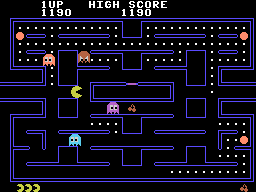 The Game: As a round yellow creature consisting of a mouth and nothing else, you maneuver around a relatively simple maze, gobbling small dots (10 points) and evading four colorful monsters who can eat you on contact. In four corners of the screen, large flashing dots (50 points) enable you to turn the tables and eat the monsters for a brief period for an escalating score (200, 400, 800 and 1600 points). Periodically, assorted items appear near the center of the maze, and you can consume these for additional points as well. The monsters, once eaten, return to their home base in ghost form and return to chase you anew. If cleared of dots, the maze refills and the game starts again, but just a little bit faster… (Atarisoft, circa 1983 [never released])
The Game: As a round yellow creature consisting of a mouth and nothing else, you maneuver around a relatively simple maze, gobbling small dots (10 points) and evading four colorful monsters who can eat you on contact. In four corners of the screen, large flashing dots (50 points) enable you to turn the tables and eat the monsters for a brief period for an escalating score (200, 400, 800 and 1600 points). Periodically, assorted items appear near the center of the maze, and you can consume these for additional points as well. The monsters, once eaten, return to their home base in ghost form and return to chase you anew. If cleared of dots, the maze refills and the game starts again, but just a little bit faster… (Atarisoft, circa 1983 [never released])
Memories: There are only so many ways you can really slice Pac-Man, but this unreleased ColecoVision edition – unearthed just in time for the 2001 Classic Gaming Expo – is one of the better ones.
Looping
 The Game: What if you were out to perform daring, air-show-style aerial acrobatics, and someone was shooting at you at the same time? Wouldn’t that be dandy? Lucky you, that’s what you’re doing in this game. With a mandate to DESTROY TERMINAL, you set out to obliterate an airport terminal protected by armed hot air balloons. The closer you get to carrying out that mission, the more fiercely they defend their turf. When you do level the terminal to the ground, a door opens up, allowing you to fly your plane into a massive maze of pipes, and if you can navigate that labyrinth, you reach “the end” – where you must fend off more adversaries to touch down safely and start again. (Coleco, 1983 – unreleased / recovered and released by CGE Services, 2003)
The Game: What if you were out to perform daring, air-show-style aerial acrobatics, and someone was shooting at you at the same time? Wouldn’t that be dandy? Lucky you, that’s what you’re doing in this game. With a mandate to DESTROY TERMINAL, you set out to obliterate an airport terminal protected by armed hot air balloons. The closer you get to carrying out that mission, the more fiercely they defend their turf. When you do level the terminal to the ground, a door opens up, allowing you to fly your plane into a massive maze of pipes, and if you can navigate that labyrinth, you reach “the end” – where you must fend off more adversaries to touch down safely and start again. (Coleco, 1983 – unreleased / recovered and released by CGE Services, 2003)
Memories: A positively obscure game in the arcades, Venture Line’s Looping really didn’t get any kind of a cult following until it was ported to the ColecoVision – and that translation was the best thing that ever happened to the game, gaining it a bit of popularity and an exclusive home.
Flash Point
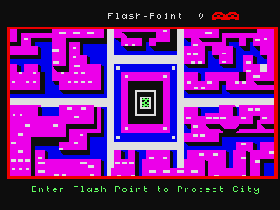 The Game: A zombie infestation has overrun the city. The player, in a mobile unit bristling with weapons, must venture into the infested areas and eliminate the zombies – or die. The center of the infestation screens features a green area surrounding the player’s vehicle; this must be preserved as much as possible while fighting off the zombies, as bonus points are awarded for guarding that space. If the player survives, it’s time to move on to the scene of the next zombie attack. (North American Philips, 1983 – unreleased prototype)
The Game: A zombie infestation has overrun the city. The player, in a mobile unit bristling with weapons, must venture into the infested areas and eliminate the zombies – or die. The center of the infestation screens features a green area surrounding the player’s vehicle; this must be preserved as much as possible while fighting off the zombies, as bonus points are awarded for guarding that space. If the player survives, it’s time to move on to the scene of the next zombie attack. (North American Philips, 1983 – unreleased prototype)
Memories: The only game custom-made specifically for the upgraded hardware of N.A.P.‘s never-released Odyssey3 console, Flash Point is a kind of action game that simply couldn’t have been executed with the same finesse on the Odyssey2.
Battlezone
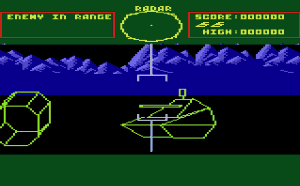 The Game: As the pilot of a heavy tank, you wander the desolate battlefield, trying to wipe out enemy tanks and landing vehicles. (Atari, 1983)
The Game: As the pilot of a heavy tank, you wander the desolate battlefield, trying to wipe out enemy tanks and landing vehicles. (Atari, 1983)
Memories: If Atari’s 2600 version of the arcade wargame was a pleasant surprise, the unreleased 5200 edition of the same game is almost a revelation. Combining adaptations of the menacingly angular vector graphics of the arcade game with more realistic raster backgrounds, the 5200 prototype is not only fun, but rather pretty to look at.
Zaxxon
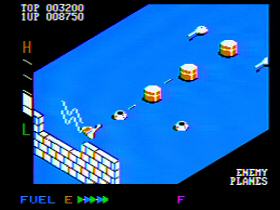 The Game: As the pilot of a lone fighter infiltrating a spaceborne fortress, your mission is simple – survive long enough to vanquish the evil Zaxxon robot hidden deep within the fortress, and take out as much of the defenses as you can in the meantime. (Datasoft, 1983)
The Game: As the pilot of a lone fighter infiltrating a spaceborne fortress, your mission is simple – survive long enough to vanquish the evil Zaxxon robot hidden deep within the fortress, and take out as much of the defenses as you can in the meantime. (Datasoft, 1983)
Memories: Probably the best of the early wave of translations of the groundbreaking arcade game, John Garcia’s Apple II edition of Zaxxon successfully boils the game down to its most vital elements: the basics of its graphical look and smooth, fast motion.
Super Demon Attack
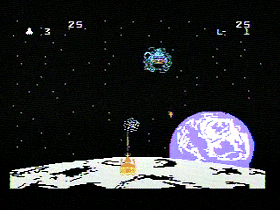 The Game: Demons coalesce into existence in mid-air above your cannon. Send them back where they came from by force. (Texas Instruments, under license from Imagic, 1983)
The Game: Demons coalesce into existence in mid-air above your cannon. Send them back where they came from by force. (Texas Instruments, under license from Imagic, 1983)
Memories: Somewhat similar to the Intellivision edition of Imagic’s Demon Attack in look and feel, this TI version of the game takes advantage of that computer’s graphics capabilities to turn the attacking demons into little pixellated pieces of Lovecraftian horror. It doesn’t make the game better or worse, really, but it adds a certain frisson to have nightmarish alien jellyfish-like critters descending upon you. Why Super Demon Attack? Because it’s got super demons, plain and simple.
Robotron: 2084
 The Game: In the year 2084, all hell has broken loose on Earth. Robotic servants, created to perform dangerous tasks and defend their human creators, have decided they can do without their masters. The robots have evolved into new and terrifying varieties – the ever-multiplying Ground Roving UNit Terminators (GRUNTs), indestructible Hulks, self-replicating Quarks and Tanks, and most horrfying of all, the Brain robots, which capture humans and reprogram them into super-fast killing machines. And the only thing protecting the last remaining survivors of homo sapiens is your strength, endurance and cunning (and the multi-directional weaponry helps too). (Atarisoft, 1983)
The Game: In the year 2084, all hell has broken loose on Earth. Robotic servants, created to perform dangerous tasks and defend their human creators, have decided they can do without their masters. The robots have evolved into new and terrifying varieties – the ever-multiplying Ground Roving UNit Terminators (GRUNTs), indestructible Hulks, self-replicating Quarks and Tanks, and most horrfying of all, the Brain robots, which capture humans and reprogram them into super-fast killing machines. And the only thing protecting the last remaining survivors of homo sapiens is your strength, endurance and cunning (and the multi-directional weaponry helps too). (Atarisoft, 1983)
Memories: I loved the arcade version of Robotron. I loved the idea of it, the graphics, the sound effects…but there was one rather major problem between me and this game: I sucked at it. Pure and simple.
Pac-Man
 The Game: As a round white creature consisting of a mouth and nothing else, you maneuver around a relatively simple maze, gobbling small dots and evading four colorful monsters who can eat you on contact. In four corners of the screen, large flashing dots enable you to turn the tables and eat the monsters for a brief period for an escalating score. Periodically, assorted items appear near the center of the maze, and you can consume these for additional points as well. The monsters, once eaten, return to their home base in ghost form and return to chase you anew. If cleared of dots, the maze refills and the game starts again, but just a little bit faster… (Atarisoft, 1983)
The Game: As a round white creature consisting of a mouth and nothing else, you maneuver around a relatively simple maze, gobbling small dots and evading four colorful monsters who can eat you on contact. In four corners of the screen, large flashing dots enable you to turn the tables and eat the monsters for a brief period for an escalating score. Periodically, assorted items appear near the center of the maze, and you can consume these for additional points as well. The monsters, once eaten, return to their home base in ghost form and return to chase you anew. If cleared of dots, the maze refills and the game starts again, but just a little bit faster… (Atarisoft, 1983)
Memories: Atari came by the code for its Apple II version of Pac-Man by the same means used by pirates of the high seas: they vanquished their foes and took their booty.
Pac-Man
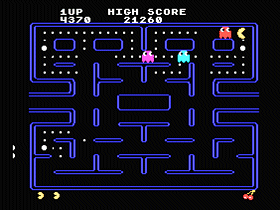 The Game: As a round yellow creature consisting of a mouth and nothing else, you maneuver around a relatively simple maze, gobbling small dots and evading four colorful monsters who can eat you on contact. In four corners of the screen, large flashing dots enable you to turn the tables and eat the monsters for a brief period. Periodically, assorted items appear near the center of the maze, and you can consume these for additional points as well. The monsters, once eaten, return to their home base in ghost form and return to chase you anew. If cleared of dots, the maze refills and the game starts again, but just a little bit faster… (Atarisoft, 1983)
The Game: As a round yellow creature consisting of a mouth and nothing else, you maneuver around a relatively simple maze, gobbling small dots and evading four colorful monsters who can eat you on contact. In four corners of the screen, large flashing dots enable you to turn the tables and eat the monsters for a brief period. Periodically, assorted items appear near the center of the maze, and you can consume these for additional points as well. The monsters, once eaten, return to their home base in ghost form and return to chase you anew. If cleared of dots, the maze refills and the game starts again, but just a little bit faster… (Atarisoft, 1983)
Memories: Having spent the better part of a year suing nearly every Pac-Man clone off the home video game market, Atari finally released its own version of the game for several consoles and home computer systems, including the TI 99/4a. TI had already released its own first-party take on the basic play mechanics of Pac-Man, Munch Man, which is generally considered one of the better arcade-style games released by TI itself. So did Atari’s “official” Pac-Man live up to its competition on the TI?
Ms. Pac-Man
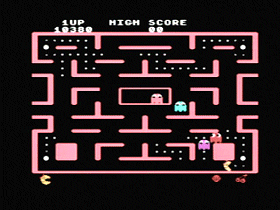 The Game: As the bride of that most famous of single-celled omniphage life forms, your job is pretty simple – eat all the dots, gulp the large blinking dots in each corner of the screen and eat the monsters while they’re blue, and avoid the monsters the rest of the time. Occasionally various fruits and other foods will bounce through the maze, and you can gobble those for extra points. (Atarisoft, 1983)
The Game: As the bride of that most famous of single-celled omniphage life forms, your job is pretty simple – eat all the dots, gulp the large blinking dots in each corner of the screen and eat the monsters while they’re blue, and avoid the monsters the rest of the time. Occasionally various fruits and other foods will bounce through the maze, and you can gobble those for extra points. (Atarisoft, 1983)
Memories: Introduced at virtually the same time as Atarisoft‘s TI edition of Pac-Man, Ms. Pac-Man looks and sounds slick – and has the same odd issue with slightly sluggish controls that seem to lag a little bit behind what’s happening on the screen.
Mr. Cool
 The Game: You’re Mr. Cool, an ice cube who chills out while hopping around a pyramid-shaped series of platforms. Fireballs streak across the pyramid from time to time, and they’ll melt you if they touch you. If you can stay cool long enough, you can advance through the game by changing the color of every platform to your target color by hopping onto each one – though in later levels it’ll take more than one hop, putting you in the path of more fireballs that could cause you to lose your cool. If you have one meltdown too many, the game is over. (Sierra On-Line, 1983)
The Game: You’re Mr. Cool, an ice cube who chills out while hopping around a pyramid-shaped series of platforms. Fireballs streak across the pyramid from time to time, and they’ll melt you if they touch you. If you can stay cool long enough, you can advance through the game by changing the color of every platform to your target color by hopping onto each one – though in later levels it’ll take more than one hop, putting you in the path of more fireballs that could cause you to lose your cool. If you have one meltdown too many, the game is over. (Sierra On-Line, 1983)
Memories: A classic case of making the best of a system’s limitations (and missing out on the official license for a popular arcade game), Mr. Cool is an unlikely collision of the game mechanics of Q*Bert and Frogger. And yet it works. In the company’s early days, Sierra was great at producing “near beer” games such as Mr. Cool and Crossfire (which approximated the game play of arcade cult classics Targ and Spectar).
Juice!
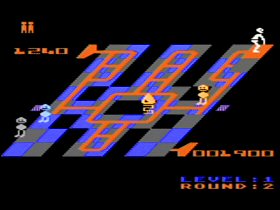 The Game: You’re the circuit maker, and they’re the circuit breakers. You hop around a maze-like structure, dropping circuitry patterns in your wake, as a variety of adversaries try to stop you from completing a circuit leading from the power source at your starting point to the receptacle across the maze from you. Colliding with any of them will cost you a life, but you can entice them to try to chase you off the maze and into oblivion while you escape safely. Completing the circuit advances you to the next maze – just on’t get too caught up in your power trip. (Tronix, 1983)
The Game: You’re the circuit maker, and they’re the circuit breakers. You hop around a maze-like structure, dropping circuitry patterns in your wake, as a variety of adversaries try to stop you from completing a circuit leading from the power source at your starting point to the receptacle across the maze from you. Colliding with any of them will cost you a life, but you can entice them to try to chase you off the maze and into oblivion while you escape safely. Completing the circuit advances you to the next maze – just on’t get too caught up in your power trip. (Tronix, 1983)
Memories: A neat combination of some well-worn game play elements, Juice is an eminently playable example of taking elements from different games and combining them into a new one. Bits of Pac-Man and Q*Bert, with a hint of Zaxxon‘s 3-D isometric perspective, combine to make Juice! unique and fun.
Gateway To Apshai
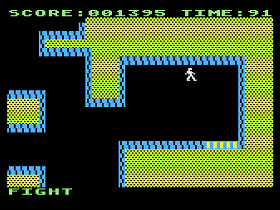 The Game: The player controls a weary adventurer weaving his way through a dungeon populated by treasures and deadly danger. Starting out with the clothes on his back, a short sword in hand, and adding what he can along the way, the player’s adventurer progresses through twisty mazes, vanquishes an increasingly dangerous rogues’ gallery of foes, and tries to gather a wealth of treasure… but even opening those treasure chests may reveal traps. (Epyx, 1983)
The Game: The player controls a weary adventurer weaving his way through a dungeon populated by treasures and deadly danger. Starting out with the clothes on his back, a short sword in hand, and adding what he can along the way, the player’s adventurer progresses through twisty mazes, vanquishes an increasingly dangerous rogues’ gallery of foes, and tries to gather a wealth of treasure… but even opening those treasure chests may reveal traps. (Epyx, 1983)
Memories: The Apshai computer RPGs form a kind of holy trinity of early adventure gaming along with the Ultima and Wizardry series of games. Gateway To Apshai is actually a prequel to the runaway hit Temple Of Apshai, which debuted on Tandy’s TRS-80 computer before cross-pollinating to every other platform under the sun. Gateway is missing Temple‘s famously wordy descriptions of its on-screen chambers, and as such feels completely different from the earlier game. But in hindsight, Gateway is an important step on the evolutionary road for the “action RPG” genre – paving the way for The Legend Of Zelda.
Donkey Kong
 The Game: How high can you go? Help Jumpman (Mario) save Pauline from Donkey Kong’s clutches by climbing ladders and avoiding barrels. (AtariSoft, 1983)
The Game: How high can you go? Help Jumpman (Mario) save Pauline from Donkey Kong’s clutches by climbing ladders and avoiding barrels. (AtariSoft, 1983)
Memories: In 1980, Space Invaders became the first arcade game to be officially licensed to a home videogame system. Sales of both the game and the Atari 2600 console itself skyrocketed, thus giving birth to a genre that still exists and sells strongly today: the arcade port. For two years, Atari released ports of arcade games for their competitors’ systems under the brand name AtariSoft. AtariSoft focused predominantly on the expanding home computer market, porting popular arcade games such as Centipede, Dig Dug and Pac-Man to the Apple II, TI-99/4A, IBM PC, and of course the best game-playing machine of the era, the Commodore 64.
Archon
 The Game: What if chess pieces were living creatures, each with its own unique abilities? And what if, every time to pieces met on the board, they had to fight amongst themselves to occupy the square in question? That’s Archon in a nutshell. (Electronic Arts, 1983)
The Game: What if chess pieces were living creatures, each with its own unique abilities? And what if, every time to pieces met on the board, they had to fight amongst themselves to occupy the square in question? That’s Archon in a nutshell. (Electronic Arts, 1983)
Memories: Whoever came up with this game is a total genius. This is the sort of game that won lots of fans in the early days who may not have necessarily been computer or video game afficionados – a modern variation on the game of chess, with arcade-flavored action segments to determine control of contested territories.
Apple Cider Spider
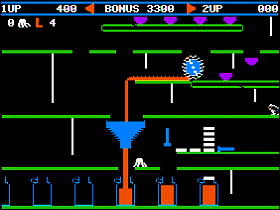 The Game: You control a spider, wandering though a factory that makes cider, and to survive this trip you better be a good hider, for the spider can’t survive with any apples that might collide ‘er. The spider can become a rider on conveyor belts, but she can also fall off if the spider tries to jump over something wider than she can navigate. The goal is to help your spider reach home despite all the perils that would divide ‘er. (Sierra On-Line, 1983)
The Game: You control a spider, wandering though a factory that makes cider, and to survive this trip you better be a good hider, for the spider can’t survive with any apples that might collide ‘er. The spider can become a rider on conveyor belts, but she can also fall off if the spider tries to jump over something wider than she can navigate. The goal is to help your spider reach home despite all the perils that would divide ‘er. (Sierra On-Line, 1983)
Memories: A cute game requiring heaps of good timing, Ivan Strand’s Apple Cider Spider takes some staples of the platform/climbing genre, adds a few twists, and pours on the cute for good measure. It’s a delightful game that’s funny because nothing really violent can happen here, aside from stumbling into a few grisly ways to die here and there. (Well, grisly if you’re a spider.)
The Dreadnaught Factor
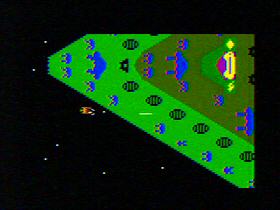 The Game: Piloting a series of solo space fighters, you’re humanity’s last hope against a fleet of gigantic, triangular wedge-shaped battle cruisers bearing down on Earth. Launching from a staging area equipped with a hyperspace gate to fling your fighters into the void at top speed, you must strafe these cruisers in your fighter, bombing and blasting their gun emplacements, engines, and an assortment of weak spots on their ship. The enemy cruisers also have defensive fighters that they’ll launch to keep you from getting the job done, and of course the cruisers themselves are bristling with enormous laser cannons. Hitting all of the guns, engines and other “soft targets” on a cruiser will destroy it, giving you a momentary reprieve until the next cruiser arrives. If you run out of ships or fail to stop the enemy, they’ll wipe out your planet – game over, indeed. (Activision, 1982)
The Game: Piloting a series of solo space fighters, you’re humanity’s last hope against a fleet of gigantic, triangular wedge-shaped battle cruisers bearing down on Earth. Launching from a staging area equipped with a hyperspace gate to fling your fighters into the void at top speed, you must strafe these cruisers in your fighter, bombing and blasting their gun emplacements, engines, and an assortment of weak spots on their ship. The enemy cruisers also have defensive fighters that they’ll launch to keep you from getting the job done, and of course the cruisers themselves are bristling with enormous laser cannons. Hitting all of the guns, engines and other “soft targets” on a cruiser will destroy it, giving you a momentary reprieve until the next cruiser arrives. If you run out of ships or fail to stop the enemy, they’ll wipe out your planet – game over, indeed. (Activision, 1982)
Memories: Further proof that long before Lucasfilm ever entered the video gaming arena, George Lucas was having a massive ripple effect on the medium: the dreadnaughts in Dreadnaught Factor are – and let’s not kid ourselves here – clearly Star Destroyers. They’re shaped and laid out like them, right down to the control tower. If you ever wanted to see what would’ve happened if Han really had taken the Millennium Falcon into a head-to-head battle with a Star Destroyer, or if that poor sap in the A-Wing hadn’t been out of control, this is your game.
Time Pilot
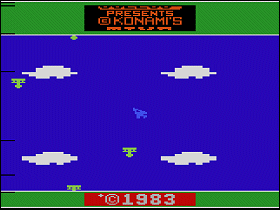 The Game: You’re flying solo through the fourth dimension! In what must be the least subtle time-traveling intervention since the last time there was a time travel episode on Star Trek: Voyager, you’re blasting your way through dozens of aircraft from 1940 through 1982. From WWII-era prop planes, to Vietnam-era helicopters, to 1982, where you confront jet fighters with the same maneuverability as your plane, you’re in for quite a wild ride. Rescue parachutists and complete the level by destroying “boss” craft such as heavy planes and dirigibles. (Coleco, 1983)
The Game: You’re flying solo through the fourth dimension! In what must be the least subtle time-traveling intervention since the last time there was a time travel episode on Star Trek: Voyager, you’re blasting your way through dozens of aircraft from 1940 through 1982. From WWII-era prop planes, to Vietnam-era helicopters, to 1982, where you confront jet fighters with the same maneuverability as your plane, you’re in for quite a wild ride. Rescue parachutists and complete the level by destroying “boss” craft such as heavy planes and dirigibles. (Coleco, 1983)
Memories: Coleco‘s home version of Time Pilot for the Atari 2600 is one of the company’s better arcade ports for that machine, and yet so much of what made the arcade game such a memorable experience was left behind. I can accept the watering-down of the game’s graphics, especially when an effort was obviously made to keep them flicker-free – an impressive feat for this game. But some of what’s left out includes the game’s very objectives.
Super Cobra
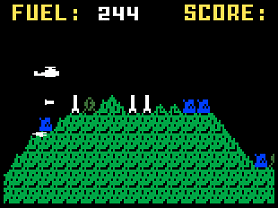 The Game: You’re piloting a heavily armed helicopter straight into a heap o’ trouble. Ground and air defenses have been mounted in this enemy installation to stop you at any costs. Missiles, anti-aircraft turrets, and even other vehicles will See the videodo anything to knock you out of the sky – and given the chunky terrain, the odds are in favor of the house. Your only saving grace is that you’re armed to the teeth. But, as you may have guessed by now, even that may not be enough to save you. (Parker Brothers, 1983)
The Game: You’re piloting a heavily armed helicopter straight into a heap o’ trouble. Ground and air defenses have been mounted in this enemy installation to stop you at any costs. Missiles, anti-aircraft turrets, and even other vehicles will See the videodo anything to knock you out of the sky – and given the chunky terrain, the odds are in favor of the house. Your only saving grace is that you’re armed to the teeth. But, as you may have guessed by now, even that may not be enough to save you. (Parker Brothers, 1983)
Memories: Parker Brothers may have been an old hand at board games, but it was a youngster in the video game business. Still, all that clout from its industry-dominating board game operation didn’t hurt, helping Parkers secure major hit licenses that no other young video game operation could’ve scored: Frogger, Q*Bert, and let’s not forget the very first Star Wars home video games. In the middle of this stellar line-up was… Super Cobra.
Stargate
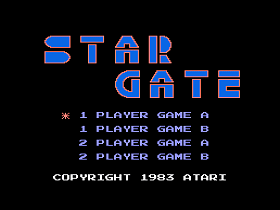 The Game: The alien abductors are back. Their henchbeings are back. And fortunately for the hapless humans on the planet’s surface, you’re back too, in a fully armed warship with a belly full of smart bombs. But the aliens have brought new and unusual reinforcements, and now the ultimate X-factor is seen visibly floating in the night sky – a stargate which could deposit your space fighter anywhere, delivering you to safety…or a rendezvous with a swarm of aliens. (Atari, 1983)
The Game: The alien abductors are back. Their henchbeings are back. And fortunately for the hapless humans on the planet’s surface, you’re back too, in a fully armed warship with a belly full of smart bombs. But the aliens have brought new and unusual reinforcements, and now the ultimate X-factor is seen visibly floating in the night sky – a stargate which could deposit your space fighter anywhere, delivering you to safety…or a rendezvous with a swarm of aliens. (Atari, 1983)
Memories: Released only in Japan in the initial burst of titles for the Famicom, this port of Williams Electronics‘ arcade sequel Stargate (also known as Defender II, a title to which the game was switched to reinforce its status as a sequel to the hit Defender). The territory-limited reach of the game is the bad news. The good news? It’s an exceptional arcade port that might just have become this reviewer’s favorite way to enjoy a legendarily difficult game.
Star Trek
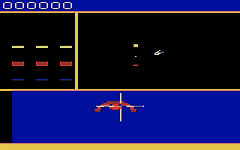 The Game: Welcome to the bridge. Your mission is to travel from sector to sector, eliminating Klingon incursions into Federation space without getting your ship and crew destroyed. Friendly starbases offer aid and allow you to make resupply stops so you can keep up the good fight – and you do have to keep a careful eye on your phaser, shield and warp power… (Sega, 1983)
The Game: Welcome to the bridge. Your mission is to travel from sector to sector, eliminating Klingon incursions into Federation space without getting your ship and crew destroyed. Friendly starbases offer aid and allow you to make resupply stops so you can keep up the good fight – and you do have to keep a careful eye on your phaser, shield and warp power… (Sega, 1983)
 Memories: Sega‘s own adaptation of its arcade game wasn’t bad. Though the Atari VCS, by its very nature, tends to force programmers to make trade-offs for game play that rob arcade adaptations of some of their luster, this one actually came out okay. If anything, this version of Star Trek was simpler than its arcade forebear – and since “bear” is the operative word for the coin-op, for once this isn’t a bad thing.
Memories: Sega‘s own adaptation of its arcade game wasn’t bad. Though the Atari VCS, by its very nature, tends to force programmers to make trade-offs for game play that rob arcade adaptations of some of their luster, this one actually came out okay. If anything, this version of Star Trek was simpler than its arcade forebear – and since “bear” is the operative word for the coin-op, for once this isn’t a bad thing.
Spike!
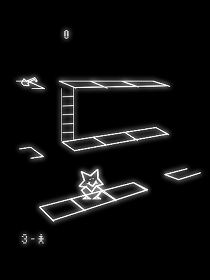 The Game: Poor Spike – his girlfriend Molly has been snatched by a beastly enemy, and it’s up to Spike to rescue her (after, of course, declaring “Darnit!”). Spike must climb his way up several ever-moving platforms. He can change the position of the ladders he uses to climb up these platforms, but it’s not as easy as simply reaching the top: to advance to the next level, Spike has to grab a key. Beastly henchmen scoot along the platforms to bump Spike off to his death, but Spike can kick them away momentarily. (GCE, 1983)
The Game: Poor Spike – his girlfriend Molly has been snatched by a beastly enemy, and it’s up to Spike to rescue her (after, of course, declaring “Darnit!”). Spike must climb his way up several ever-moving platforms. He can change the position of the ladders he uses to climb up these platforms, but it’s not as easy as simply reaching the top: to advance to the next level, Spike has to grab a key. Beastly henchmen scoot along the platforms to bump Spike off to his death, but Spike can kick them away momentarily. (GCE, 1983)
Memories: The first voice-synthesis game for GCE‘s already wildly innovative Vectrex console, Spike missed being the first home video game to produce voice synthesis without additional hardware by mere months (wait for it, wait for it… “Darnit!”). (The prize, if anyone’s counting, went to Atari‘s RealSports Baseball for the Atari 5200.) But that’s not the only neat trick Spike! brought to the table.
Shuttle Orbiter
 The Game: Piloting the space shuttle, you must navigate your way from a low orbit to a high one, stopping at a refueling satellite and ferrying modules to a space station under construction. While gaining altitude, you may run through fields of space debris; allowing them to hit the shuttle costs you precious fuel. (Avalon Hill, 1983)
The Game: Piloting the space shuttle, you must navigate your way from a low orbit to a high one, stopping at a refueling satellite and ferrying modules to a space station under construction. While gaining altitude, you may run through fields of space debris; allowing them to hit the shuttle costs you precious fuel. (Avalon Hill, 1983)
Memories: Ah…simpler times. Truth be told, I love space exploration games – no alien encounters, no blasting doomsday asteroids out of a collision course with Earth, none of that. Just get the job done and get home safely.
Spider-Man
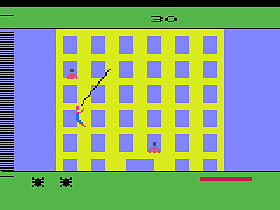 The Game: The Green Goblin and his henchmen are terrorizing the city once more, and it’s up to Spider-Man to restore order. But the odds are against him: he can only attach his web to the surface of the building, naturally, but the Goblin’s underlings are ready and eager to cut Spidey’s web should it be planted near them. Worse yet, the difficult-to-navigate high voltage tower at the top of the building is riddled with the Goblin’s bombs, and even if Spidey can defuse them, there’s a Super Bomb waiting for him at the top of the building – and he can only put it out of commission after dealing with the Green Goblin personally. (Parker Brothers, 1983)
The Game: The Green Goblin and his henchmen are terrorizing the city once more, and it’s up to Spider-Man to restore order. But the odds are against him: he can only attach his web to the surface of the building, naturally, but the Goblin’s underlings are ready and eager to cut Spidey’s web should it be planted near them. Worse yet, the difficult-to-navigate high voltage tower at the top of the building is riddled with the Goblin’s bombs, and even if Spidey can defuse them, there’s a Super Bomb waiting for him at the top of the building – and he can only put it out of commission after dealing with the Green Goblin personally. (Parker Brothers, 1983)
 Memories: What if…Crazy Climber was mad as hell and wasn’t going to take it any more? That’s almost what Spider-Man seems like on the Atari 2600. Though I will step away from the comparison and point out that Spider-Man is a lot more challenging than the 2600’s less than stellar rendition of Crazy Climber. Simply getting a “foothold” (web-hold?) for your next ascent is a huge challenge, and getting to your next temporary destination is always a dicey deal. Unlike that other scaler of buildings, however, Spidey can catch himself in mid-fall – if he’s in the right place and you’re really fast.
Memories: What if…Crazy Climber was mad as hell and wasn’t going to take it any more? That’s almost what Spider-Man seems like on the Atari 2600. Though I will step away from the comparison and point out that Spider-Man is a lot more challenging than the 2600’s less than stellar rendition of Crazy Climber. Simply getting a “foothold” (web-hold?) for your next ascent is a huge challenge, and getting to your next temporary destination is always a dicey deal. Unlike that other scaler of buildings, however, Spidey can catch himself in mid-fall – if he’s in the right place and you’re really fast.
Spectron
 The Game: Aliens are closing in on your planetary base, and apparently you’re the only one on call to fend them off. Shields protect your ground-hugging mobile cannon, but they tend to be eroded away quickly by both incoming enemy fire and your own shots from the ground. If enemy ships infiltrate your protective bunker, you can find yourself in a very close-quarters firefight. When you eliminate a wave of alien ships, the next wave moves in to attack. (Spectravideo, 1983)
The Game: Aliens are closing in on your planetary base, and apparently you’re the only one on call to fend them off. Shields protect your ground-hugging mobile cannon, but they tend to be eroded away quickly by both incoming enemy fire and your own shots from the ground. If enemy ships infiltrate your protective bunker, you can find yourself in a very close-quarters firefight. When you eliminate a wave of alien ships, the next wave moves in to attack. (Spectravideo, 1983)
Memories: “Oh no!” you might be saying, “Not another Space Invaders clone!” But the thing is, as obvious a genre of game as that might have been on nearly every other console in existence, Spectron is one of the very few such games that was released for the Colecovision during the console’s heyday.
Space Shuttle: A Journey Into Orbit

 The Game: You’re the pilot of the space shuttle. And the mission specialist too, apparently. (Hey, everyone’s making staffing cutbacks these days.) You must keep the orbiter on target during launch, not allowing it to drift off course, and then you must retrieve, repair and re-deploy a satellite. Then augur the shuttle in for a smooth landing – and then get in line for your next mission, which begins almost immediately after your previous one. (Did we mention that, in this game’s universe, you’re NASA’s only shuttle pilot and mission specialist?) (Activision, 1983)
The Game: You’re the pilot of the space shuttle. And the mission specialist too, apparently. (Hey, everyone’s making staffing cutbacks these days.) You must keep the orbiter on target during launch, not allowing it to drift off course, and then you must retrieve, repair and re-deploy a satellite. Then augur the shuttle in for a smooth landing – and then get in line for your next mission, which begins almost immediately after your previous one. (Did we mention that, in this game’s universe, you’re NASA’s only shuttle pilot and mission specialist?) (Activision, 1983)
Memories: Activision‘s excessively cool shuttle flight sim piqued my interest just as a later Apple II resource-management game, Project Space Station, did. I’ve always liked the idea of a modern-day (or five-minutes-into-the-future, as was the case with Project) space sim that doesn’t involve blowing stuff up.
Sky Jinks

 The Game: It’s a lovely day for a little bit of prop flying. You’re at the stick of a small, single-engine plane, and you must complete an increasingly difficult succession of courses where you must pass different colored pylons on the left or right. But there are obstacles that don’t make this easy – several balloonists also agree that it’s a good day to take to the air, and then there are the trees… (Activision, 1983)
The Game: It’s a lovely day for a little bit of prop flying. You’re at the stick of a small, single-engine plane, and you must complete an increasingly difficult succession of courses where you must pass different colored pylons on the left or right. But there are obstacles that don’t make this easy – several balloonists also agree that it’s a good day to take to the air, and then there are the trees… (Activision, 1983)
Memories: I can’t tell you how many hours I spent with this game as a kid. It drove me nuts! I could whip around like a flying ace on the easy courses, but never failed to wipe out on the more advanced ones.
Robot Tank
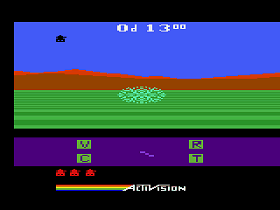
 The Game: So much for the tank platoon. You’re in charge of a lone robotic tank on a battlefield buzzing with bad guys. A radar sweep gives you advance notice of approaching enemies, but there are so many of them out there that even that warning may not come soon enough. A series of critically-placed blasts could leave you immobile, or worse yet, unarmed and helpless to do anything but take a pounding until it’s all over. Repair systems can restore these lost abilities – if you survive that long. The fighting doesn’t stop at night either – the sun goes down, leaving you in the dark for several minutes, capable of fighting and navigating only by instrumentation with little in the way of visual cues. (Activision, 1983)
The Game: So much for the tank platoon. You’re in charge of a lone robotic tank on a battlefield buzzing with bad guys. A radar sweep gives you advance notice of approaching enemies, but there are so many of them out there that even that warning may not come soon enough. A series of critically-placed blasts could leave you immobile, or worse yet, unarmed and helpless to do anything but take a pounding until it’s all over. Repair systems can restore these lost abilities – if you survive that long. The fighting doesn’t stop at night either – the sun goes down, leaving you in the dark for several minutes, capable of fighting and navigating only by instrumentation with little in the way of visual cues. (Activision, 1983)
Memories: Just as Activision beat Parker Bros.‘ rendition of Frogger to the punch with Freeway, they also bested Atari’s own unexpectedly impressive Atari 2600 port of Battlezone with their own first-person tank entry, Robot Tank. Designed and programmed by Alan Miller, Robot Tank has some of Activision’s familiar signatures – the near-impossible color palette they squeezed out of the 2600, the almost flicker-free graphics, and just plain addictive game play. But in this case, Atari’s home version of Battlezone was no slouch either, so it’s hard to pick a clear winner.
River Raid
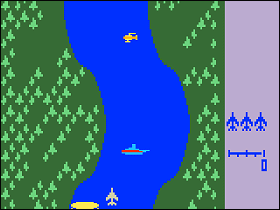 The Game: You’re piloting a fighter jet on a canyon run through enemy territory. You can’t fly outside the canyon walls, so stay over the river and blast everything in sight. Well, almost everything – flying your plane on top of “FUEL” buoys instead of shooting them puts a little bit of gas in the tank, and if you run out of fuel, you might as well just swallow the next enemy bullet, because you’re goin’ down. (Activision, 1983)
The Game: You’re piloting a fighter jet on a canyon run through enemy territory. You can’t fly outside the canyon walls, so stay over the river and blast everything in sight. Well, almost everything – flying your plane on top of “FUEL” buoys instead of shooting them puts a little bit of gas in the tank, and if you run out of fuel, you might as well just swallow the next enemy bullet, because you’re goin’ down. (Activision, 1983)
Memories: Early in Activision‘s foray into publishing games for the Intellivision, the company issued a strange edict to its programmers: if it was a port of a game also released for the Atari VCS, don’t make the game look significantly different from the Atari version. River Raid is a good example of what happened once Activision abandoned that extremely odd policy.